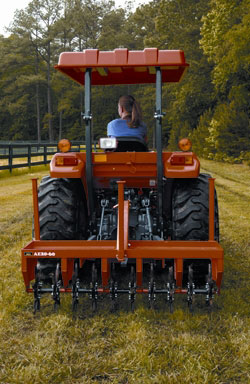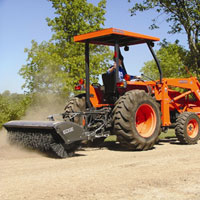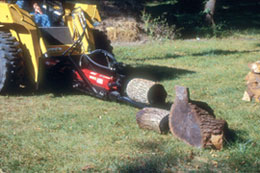Fall Implements
 With Transformers being this summer’s robotic blockbuster movie event, we felt it apropos to talk about the original mechanical Autobots. The tractor was one of the first equipment inventions that could actually transform from application to application – from plow to combine to wagon to harrow and onward.
With Transformers being this summer’s robotic blockbuster movie event, we felt it apropos to talk about the original mechanical Autobots. The tractor was one of the first equipment inventions that could actually transform from application to application – from plow to combine to wagon to harrow and onward.
These machines first began to catch on once Henry Ford released his Fordson (the first mass produced tractor in 1917); the prototype was called the “automobile plow.” Harry Ferguson (one half of today’s Massey Ferguson) patented the three-point hitch for agricultural tractors in Britain in 1926. Of course, it took till the 1960s before tractor and implement manufacturers would finally agree on the three-point hitch as the one standard system to attach implements to tractors. As the patents on the technology expired, the manufacturers were able to refine the system and create increasingly useful modifications, creating the ultimate tractor transformer.
Implements are big business today. For a large estate owner, hobby farmer or sundowner, a compact tractor can be an all-purpose machine to spearhead the many maintenance and construction operations on their palatial spread. That versatility is from the ability to run implements off their 540-rpm Power Take-Off system (PTO), engineered into a three-point hitch on the back, using Category 1 attachments to get the job done. Today, implements can even run from a mid-mount PTO (beneath the machine with attachments like belly mowers and angle blades) and off the front hydraulics (with augers and buckets).
While there are countless models, brands and sizes of implements, three of the most popular attachments for large estate owners are brooms, disc harrows and log splitters. Equipped with this triad of implements, tractor owners can transform their tool carrier into the Optimus Prime of their estate for the fall work season.
Serious Sweepers
The season of the witch always calls for a few brooms. With that October harvest moon nearly on the horizon, a sweeper is a great choice for cleaning leaves and snow, as well as every other mop up job – from caked on dirt to grass clippings. Most broom attachments for compact tractors are categorized by width (in sizes from 48 to 84 in.), the way they attach (rear or front) and the style of sweep (angle or push). When choosing a broom for your compact tractor, you want to make sure the width of the broom at full angle is greater than the width of the tractor and the PTO hp of the tractor is able to run the broom. Many brooms today are offered as front-mounted.
“All of the Massey Ferguson brooms offered are front mounted with a patented quick-hitch for easy removal,” says Chris Box, product specialist with Massey Ferguson brooms. “To run a broom on a Massey Ferguson compact tractor, you must have a mid PTO with a driveline to operate it, along with tractor hydraulics to lift the broom. Massey Ferguson brooms run off a chain and sprocket final drive.”
Many manufacturers offer similar hydraulically-powered brooms, but most tractors would need a PTO-driven hydraulic pump to operate these brooms. If a tractor has a universal mount on the loader and has around 10 or 12 gpm of hydraulic flow, a hydraulically-powered broom can usually be run from the front of the tractor.
Other options are available for the tractor and are usually powered from the rear PTO. There are also push brooms available for the rear of the tractor; this is a static mounted broom that does not require a PTO connection, but can be angled with a hydraulic cylinder if hydraulics are available. Push brooms can be very efficient and cost-effective for light sweeping jobs, but angle brooms are more common.
“Angle brooms cost from $3,700 to $4,000, while push brooms typically cost from $1,900 to $2,300,” says Sarah Falkavage, sales and marketing specialist at CEAttachments Inc., a wholesale distributor of a wide range of attachments for compact equipment, based in Cedarburg, Wis. “Brooms can be used to sweep snow and debris from driveways, sidewalks and paths. If used with all poly bristles, angle brooms can also be used to de-thatch lawns.”

Storage stands are a common option for brooms to keep weight off the bristles when the unit is being stored; these usually cost around $350. Hydraulic angle kits are also available for tractors that have hydraulic remotes; these run from $350 to $550. Dust shields are also available.
“Maintain the broom rpm and vary ground speed to allow the broom to sweep and move debris,” says Jerry Dieker, marketing manager for implements at New Holland. “Your broom can easily handle up to 5 in. of snow, making cleanup a fast and fun experience. Just make sure your quick-hitch allows you fast and easy hook-up and disconnect for movement between cleanup with your rotary broom and more demanding material movement with your front-mounted blade.”
The Disc and the Harrows
Much like its cousin the landscape rake, disc harrows are used to prepare plots of unscaped earth for different uses. Instead of smoothing soil, disc harrows (also called finishing discs or double-offset discs) are used to open the ground and pulverize the soil in preparation for seeding. Disk harrows also do an excellent job of incorporating crop residue into the soil, thus accelerating the decomposition of this material and enhancing the soil’s potency.
Higher plant populations, no-till soybeans and genetically-modified crops with tougher stalks and stems, don’t deteriorate as fast over winter as conventional hybrids do and are all to blame for increased amounts of residue. A disc harrow can be a good defense – other implements may size residue but not mix it with the soil and some mix without sizing. Disc harrows can do both because of their design. Rows of concave discs arranged in an X pattern run at an angle to both slice and mix material without plugging like a shank-type tool can.
The front rows throw soil outward and the back rows throw soil inward, leaving an even layer of mulch to meet requirements of the conservation-type farmer. The same disc can be used to level ruts in the field left by trucks and grain carts, incorporate surface-applied manure or control weeds and promote soil warm-up in the spring before planting. This attachment usually has two sets of disc openers on a front gang and two sets of disc openers on a rear gang.
“Discs often have trailing, spring-loaded cultivator shovels to assist in weed and trash removal and in the formation of small furrows,” says Bill Chestnut, product manager at Land Pride, an attachment manufacturer based in Salina, Kan. “Discs are sized to a tractor by matching the tractor’s horsepower output to that of the disc horsepower requirement.”
Disc Harrows come in varying widths and blade diameters, often available in 66- or 78-in. widths with 16- or
18-in. blades. Disc harrows run off the back of the tractor and most compact utility tractors that are 20 hp and up will handle a disc harrow without problems. There are two main types of harrow discs – smooth and notched. Both are static attachments, which do not require hydraulics.
Expect to pay about $1,000 to $3,500 for a quality disc harrow. Although the purpose and use of a disc harrow is rather basic, the attachment’s overall performance is dependent on both blade style and soil quality.
“The disc width should cover the tire tracks. Make sure the tractor has the horsepower to lift and pull the disk in your soil conditions. Your disc’s configuration should match your individual conditions,” says Dan Paschke, product manger of compact utility tractors for John Deere Commercial & Consumer Equipment Division.
“Do you want to chop residue? If so, choose notched blades. Do you want a smoother, finer seedbed? If so, choose smooth blades. Also, depending on your conditions, you may consider adding other options such as scraper blades for wetter conditions, furrow-fillers for preparation of seed beds or center-sweeps to enhance coverage between blades. Notched blades are more aggressive and are ideal to break harder ground or high residue areas. Smooth blades work best in softer and wetter soil conditions. The most popular configurations are notched front blades and notched or smooth rear blades.”
The Great Divide
Fire is one of man’s greatest discoveries, but to feed those flames, it takes a log of firewood. Today, making firewood is still work, but modern splitters are more productive and faster than ever. With a good source of raw materials and the right machine, you can keep you and the family warm without spending all of your time working up the woodpile.

Some log splitters that attach to tractors can be used in a horizontal or vertical position. The cheaper models don’t have separate engines or hydraulic pumps and rely solely on the tractor’s power plant and hydraulic system. That results in much lower power to the piston of the splitter and universally slower cycle times. Another issue is the length of log that will fit in the splitter trough. A few select manufacturers build splitters that will accommodate logs 4 to 36 in. long – perfect for outdoor furnace owners.
A good example of a PTO-driven splitter is the TW-3HD manufactured by Timberwolf. It runs on any tractor, 16-hp and up with a Category 0 or 1 PTO hookup. Available in lengths up to 48-in., the TW3-HD offers labor-saving options like a six-way wedge, auto-cycle valve, hydraulic log lift, hydraulic wedge lift and table grate. This unit comes standard with a 20-gpm PTO pump and a commercial grade Honda engine, yielding 22 tons of splitting force.
One could expect to pay around $2,000 or more for a log splitter depending on the size of the machine. The pricing equation will revolve around speed, durability and options. For example, some manufacturers offer four- or six-way splitting wedges as an option. By just upgrading to a four-way wedge, you immediately double your production with the same amount of work. Some units can change positioning simply by pulling a pin, pivoting the unit and replacing the pin. Another excellent back-saver is the table grate. The table grate catches the split logs at waist level, so you don’t have to reach to the ground to pick them up. A hydraulic log lift can take the load off when you have to hump those big chunks up onto the splitting bed. Ask for a hydraulic log lift, and let the machine do all of the work.
Just shop around; there are always unique alternatives.
“CEAttachments carries one log splitter for tractors around 20 hp and it attaches to a Cat 1 or Cat 2 three-point hitch,” says Falkavage. “There are also log splitters available with a universal skid steer mount too, which is available on some tractor loaders today. A hydraulic cylinder is what splits the logs, so yes, hydraulics are required.”

Comments are closed here.